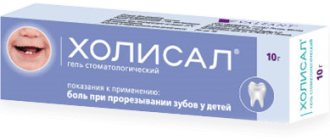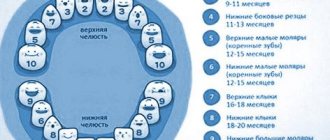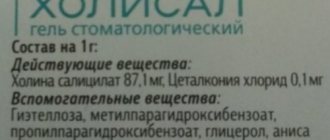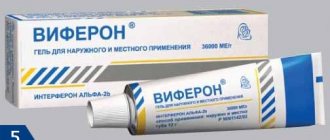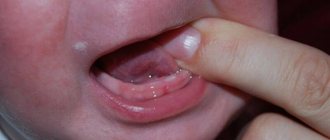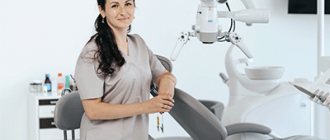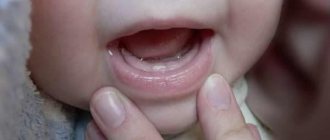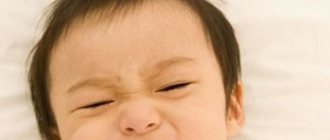The period when babies erupt their first baby teeth is a rather difficult time for parents. But this process also brings a lot of unpleasant sensations to the baby himself. Pain, increased body temperature, profuse salivation - these are only minimal manifestations that accompany the appearance of almost every new tooth. We will try to tell you about what products can be used for gums during teething in children, as well as how you can alleviate discomfort and pain in a child.
All medications that are used to alleviate unpleasant symptoms during teething are divided into the following groups:
- topical preparations (ointments, gels, creams);
- painkillers and anti-inflammatory drugs in the form of drops for oral use;
- homeopathic medicines.
How do these medications work for teething?
The action of gels and ointments with an analgesic effect is based on the presence in their composition of an anesthetic substance (for example, lidocaine or another) that blocks pain receptors that are located on the surface of the gums. They may additionally contain plant extracts and anti-inflammatory components that help eliminate inflammatory manifestations that occur during teething.
Almost immediately after their application, the effect occurs, but the effect of such a medicine is insignificant, most often no more than half an hour.
An indication for the use of painkillers and anti-inflammatory drugs is an elevated temperature in a child during teething and severe pain.
Most often they are given to the baby orally. After taking such medications, the effect can be seen within 30-40 minutes, while their effect is quite long - up to 12 hours.
It is not advisable to get carried away with such drugs and give them to newborn children unless absolutely necessary.
Homeopathic remedies contain natural ingredients that act throughout the baby’s body. At the same time, the clinical manifestations of gum inflammation are reduced, pain is relieved and the process of teething in the baby is accelerated.
Let's take a closer look at each group of drugs.
Symptoms of the onset of baby teeth
First of all, parents need to be able to recognize when the teething process has begun. The appearance of the first teeth has the following symptoms:
- inflammation and redness of the gums;
- increased salivation;
- change in the child’s appetite (the baby may refuse food altogether or, conversely, try to eat inedible);
- biting and attempts to gnaw everything on the part of the child (due to the fact that the gums itch during teething);
- not a significant increase in body temperature for a period of 1-2 days (due to the fact that an increased amount of biologically active substances is released in the body);
- slight (up to 3 days, with a frequency of up to 3 times a day) diarrhea, due to the fact that salivation increases and a lot of saliva enters the child’s gastrointestinal tract;
- mild runny nose (clear nasal discharge for about 4 days);
- wet cough (also due to increased salivation);
- lack of sleep (due to discomfort).
What problems can arise during teething?
- Teeth cutting too late. A period of more than 2 months from the moment when they should have started to erupt is considered late.
- Teeth are cutting too early. Although there are cases when a child is born with teeth already erupted. But still, if teeth begin to appear for the most part too early, this is a cause for concern.
- The appearance of teeth outside the dentition.
- Incorrect formation of newly erupted teeth.
- Violation of the order of eruption of the incisors or the absence of one of the teeth.
If symptoms (fever or runny nose) last longer than a couple of days, the child should be seen by a doctor immediately!
Local preparations
Kamistad Baby
Kamistad Baby is a combined dental gel for children that has local anesthetic, antibacterial and anti-inflammatory effects. It contains lidocaine and chamomile tincture, which ensure rapid penetration of the drug to the affected area, as well as complete elimination or weakening of pain for a while. This group includes various pain-relieving creams, gels and ointments for gums - the most popular products that used for teething in babies. They can easily be applied to a swollen or inflamed area on the gum, thereby relieving unpleasant symptoms. Often, it is possible to determine which particular remedy will work better only after personal experience of using them, since each child has individual sensitivity to various components of the drug.
Kalgel
It is a dental gel consisting of a combination of the local anesthetic lidicaine and the antiseptic cytilperidine, which is active against many fungi and bacteria.
Kalgel begins to act after 1-2 minutes from the moment of application, the effect lasts for 10-15 minutes. The gel can be reused for severe pain, but it is advisable not to use it more than 6 times a day. The gel can be used not only to alleviate the baby’s condition during teething, but also for thrush in the oral cavity.
Dentinox gel
Dentinox is a gel that helps relieve painful teething. The anesthetic effect can be achieved due to the presence of lidocaine in its composition. In addition, due to the presence of polidocanol and chamomile tincture in the composition, it has an anti-inflammatory effect, due to which the growth of pathogenic microflora is suppressed.
This gel can be used several times a day, its effect lasts approximately 15 minutes. There is no sugar in the preparation, so there is no possibility of any negative effect on the teeth.
Cholisal gel
The main components of this dental gel are cetalkonium chloride and choline salicylate, which are characterized by a pronounced analgesic, antibacterial and anti-inflammatory effect. To relieve pain, just apply a little gel to the area of gum inflammation. Due to the special structure of the drug, it is retained on the surface of the mucous membrane, which ensures a fairly long-lasting effect (about 2-3 hours).
Anti-inflammatory toothpastes for children –
In the arsenal of oral hygiene products for young children, there are several toothpastes that have an anti-inflammatory effect and reduce gum sensitivity during teething. Their use on an ongoing basis for child oral hygiene will increase the effectiveness of the use of gels for topical use or systemic homeopathic preparations (24stoma.ru).
- Weleda children's toothpaste-gel (from 0 to 3 years)
contains the following active components - calendula extract, alginate, esculin, essential oils of mint and fennel, which have an anti-inflammatory effect. Does not contain sodium lauryl sulfate, preservatives, dyes, fluorine. Price for a 50 ml tube – from 350 rubles (made in Germany).
- SPLAT “BABY Vanilla” paste (from 0 to 3 years) is made in Russia, and the active ingredients are licorice extract, prickly pear extract, arginine, a complex of lactic enzymes (lysozyme, lactoferrin, glucose oxidase, lactoperoxidase). Most of these components have an anti-inflammatory effect and reduce the sensitivity of the gums during teething. Price per tube 40 ml from 150 rubles.
- Foam SPLAT “Junior Magic Foam” (any age) – this foam for cleansing teeth contains licorice extract, a complex of lactic enzymes, as well as creatine and dipotassium glycyrrhizinate. All these components have an anti-inflammatory effect on the oral mucosa during teething. The cost will be starting from 260 rubles (per 50 ml tube).
Drops for oral administration
Preparations in the form of drops for internal use are antihistamines that help relieve swelling from the mucous membranes, thereby eliminating all unpleasant symptoms.
Fenistil drops
Fenistil drops help relieve swelling of the oral and nasal mucosa, which helps relieve unpleasant symptoms such as pain and difficulty breathing through the nose when teething in babies. The drug can be used up to three times a day.
Parlazin
Another antiallergic drug that can be used in case of difficulties with the appearance of baby teeth. The drug Parlazin is available in drops. Due to its long-lasting action, it can only be used once a day. After taking this remedy, swelling of the mucous membranes decreases and nasal breathing improves.
Teething at three months of age: normal or pathological
When the baby is very small, parents often associate his anxiety, fever and the appearance of other undesirable symptoms with illness, but not with the appearance of his first teeth. After all, the average time for teething is within 6–8 months. But pediatric dentistry knows many cases when the process begins earlier than this time frame. Therefore, parents need to prepare to help their child at any time.
Homeopathic medicines
For children, a small amount of homeopathic remedies is used. They contain exclusively natural components that have a pronounced analgesic and anti-inflammatory effect.
Ointment Traumeel S
Traumeel S is one of the most popular homeopathic remedies with anti-inflammatory effects in the form of an ointment. Used for teething. Herbal components help relieve swelling and inflammation of the gums and relieve pain. To achieve maximum effect, it is enough to apply a thin layer of ointment to the oral mucosa; repeat the procedure 2-3 times a day.
Dentinorm Baby drops
Homeopathic drops that are used for teething in babies are Dentinorm Baby, produced by Boiron (France). This is a multicomponent drug that has a combined effect. The ingredients included in the composition help eliminate the discomfort that accompanies the appearance of the first baby teeth. Drops are produced in convenient containers that contain one dose of the drug, thereby minimizing the risk of a possible overdose. Duration of administration: 3 days, no more than 2-3 times a day.
Although all medications are used to relieve teething symptoms, they should not be used without first consulting your pediatrician. Like other drugs, they have side effects and contraindications that should not be forgotten.
Add a review (comment)
By submitting this form you accept the privacy policy.
Which gel is better to choose
To determine which teething gels help best, first of all, you need to familiarize yourself with their composition. Thus, the effectiveness of drugs containing lidocaine and other anesthetics directly depends on the amount of these components in them - the higher it is, the faster the pain relief effect occurs. And although pain relief occurs almost instantly, its return occurs just as quickly - usually 20 minutes after applying the gel. Anesthetic-based products include: Dentol, Kamistad, Kalgel and Dentinox.
«
Another type of no less effective gels for teething are preparations based on completely natural or semi-synthetic components. For example, these include: Cholisal, Baby Doctor and Pansoral. Compared to anesthetic-based gels, these products may have a less pronounced but longer-lasting analgesic effect, which is the result of not just blocking pain with plant substances, but eliminating the cause of its development - inflammation of the gum mucosa.
In general, all of the listed dental gels for newborns or teething children, in addition to their own advantages, have a common drawback - the risk of developing allergies. Therefore, when choosing a gel for teething, you should focus both on the allergic status of the baby and on the previously announced features of the action of each of the groups of drugs.
Thus, gels with an anesthetic will be more effective in a situation where a child has severe pain, which cannot be relieved by natural ingredients. And gels for infants based on plant substances are best suited for moderate deterioration in health, when natural pain relief by reducing inflammation will be sufficient.
«
Cooling agents with anesthetics
This is the largest group of drugs that are used to relieve pain in children during the eruption of baby teeth. Most contain lidocaine, a local anesthetic that begins to work within five minutes of application. Lidocaine has the same properties as novocaine, but the effect of its use occurs faster, so this anesthetic is considered the drug of choice in the production of pain-relieving gels for infants.
Teething pattern
Experts include the following disadvantages of lidocaine-based products:
- short period of pain relief (in infants with a low pain threshold and increased sensitivity, painful sensations may return within 20-30 minutes after applying the drug);
- high probability of allergic reactions;
- a large list of side effects, including breathing difficulties, neurological disorders, seizures and other serious consequences;
- numbness of the mouth, which can cause additional anxiety for the baby.
Baby is cutting teeth
One of the most popular products that contain lidocaine is the Kalgel dental gel. It also contains cetylpyridinium (in the form of chloride), an antiseptic drug that disinfects the oral cavity and destroys pathogenic bacteria and microbes. It can be used from the age of five months no more than 5-6 times a day.
"Kalgel"
The Kamistad dental gel has a similar effect. To eliminate pain during teething, you can use the children's form of the drug - “Kamistad Baby”. It does not contain lidocaine, so it is considered a safer dosage form and is suitable for use from three months of age. The analgesic effect is achieved by adding a cooling flavoring additive. Chamomile extract soothes the gums, reduces the intensity of itching, reduces the severity of inflammation and disinfects the oral cavity, preventing the development of pathogenic flora.
You can use Kamistad Baby 2-3 times a day. It is better to do this after feeding or in between meals. The last application is recommended before bedtime.
"Kamistad Baby"
An analogue of Kamistad is the dental drug Dentinox, which is available in the form of a solution or dental gel. It contains lidocaine and chamomile extracts and helps eliminate pain, reduce inflammation and reduce the intensity of itching. The product should be used up to three times a day. If the product is used in the form of a solution, a single dosage is 2-3 drops. They must be gently rubbed into the gums at the site of tooth eruption using a finger or a cotton swab.
"Dentinox"
Important! All products that contain lidocaine have contraindications and side effects. These medications should not be used if the child has low blood pressure. Contraindications for use are also heart failure, liver or kidney dysfunction, and bradycardia. After applying products with lidocaine, it is necessary to monitor the child’s condition, since one of the side effects is impaired swallowing function.
